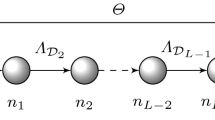Abstract
In this paper, statistical characterizations of mobile radio channels that do not satisfy the assumption of wide-sense stationary uncorrelated scattering (WSSUS) are discussed, most importantly the local scattering function. The framework presented is particularly suited for doubly underspread non-WSSUS channels. Application examples and measurement results illustrate its practical usefulness.
Abstract
In diesem Artikel wird die statistische Beschreibung von Mobilfunkkanälen behandelt, welche nicht die Annahme schwach stationärer unkorrelierter Streuer erfüllen. Besondere Beachtung hierbei findet die lokale Streufunktion. Die vorgestellten Methoden, welche besonders für schwach dispersive und schwach korrelierte Kanäle geeignet sind, werden anhand von Anwendungsbeispielen und Messergebnissen veranschaulicht.
Similar content being viewed by others
References
Bello, P. A. (1963): Characterization of randomly time-variant linear channels. IEEE Trans. Comm. Syst. 11: 360–393.
Biglieri, E., Proakis, J., Shamai, S. (1998): Fading channels: information-theoretic and communications aspects. IEEE Trans. Inf. Theory 44: 2619–2692.
Boche, H., Jorswieck, E. (2002): Analysis of diversity and multiplexing tradeoff for multi-antenna systems with covariance feedback. In: Proc. IEEE VTC-2002, Vol. 2, Sept. 2002: 864–868.
Bultitude, R. J. C., Brussaard, G., Herben, M. H. A. J., Willink, T. J. (2000): Radio channel modelling for terrestrial vehicular mobile applications. In: Proc. MIllenium Conf. Antennas and Propagation, Davos, Switzerland, April 2000.
Chow, S.-K., Venetsanopoulos, A. N. (1974): Optimal on-off signaling over linear time-varying stochastic channels. IEEE Trans. Inf. Theory 20: 602–609.
Correia, L. M. (ed.) (2001): Wireless flexible personalised communications. COST 259 Final Report. Chichester: Wiley.
Dossi, L., Tartara, G., Tallone, F. (1996): Statistical analysis of measured impulse response functions of 2.0 GHz indoor radio channels. IEEE J. Sel. Areas Comm. 14: 405–410.
Gehring, A., Steinbauer, M., Gaspard, I., Grigat, M. (2001): Empirical channel stationarity in urban environments. In: Proc. EPMCC 2001, Vienna, Austria, Feb. 2001.
Herdin, M. (2004): Non-stationary indoor MIMO radio channels. PhD thesis, Vienna University of Technology.
Jachan, M., Matz, G., Hlawatsch, F. (2003): Time-frequency-autoregressive random processes: Modelling and fast parameter estimation. In: Proc. IEEE ICASSP-2003, Vol. 6, Hong Kong, April 2003: 125–128.
Kattenbach, R. (1997): Considerations about the validity of WSSUS for indoor radio channels. COST 259 TD(97)070, Lisbon, Sept. 1997.
Kennedy, R. S. (1969): Fading dispersive communication channels. New York: Wiley.
Kivinen, J., Zhao, X., Vainikainen, P. (2001): Empirical characterization of wideband indoor radio channel at 5.3 GHz. IEEE Trans. Antennas and Propagation 49: 1192–1203.
Matz, G. (2003a): Characterization of non-WSSUS fading dispersive channels. In: Proc. IEEE ICC-2003, Anchorage, AK (May 2003): 2480–2484.
Matz, G. (2003b): Doubly underspread non-WSSUS channels: analysis and estimation of channel statistics. In: Proc. IEEE SPAWC-03, Rome, Italy, June 2003.
Perez, V., Jimenez, J. (eds.) (1994): Final propagation model. RACE CoDiT deliverable R2020/TDE/PS/DS/P/040/b1.
Proakis, J. G. (1995): Digital communications, 3rd ed. New York: McGraw-Hill.
Sayeed, A. M., Aazhang, B. (1999): Joint multipath-Doppler diversity in mobile wireless communications. IEEE Trans. Comm. 47: 123–132.
Schafhuber, D., Matz, G. (2005): MMSE and adaptive prediction of time-varying channels for OFDM systems. IEEE Trans. Wireless Comm. 4.
Schafhuber, D., Matz, G., Hlawatsch, F. (2001): Simulation of wide-band mobile radio channels using subsampled ARMA models and multistage interpolation. In: Proc. 11th IEEE Workshop on Statistical Signal Processing, Singapore, Aug. 2001: 571–574.
Steinbauer, M. (2001): The radio propagation channel — a non-directional, directional, and double-directional point-of-view. PhD thesis, Vienna University of Technology.
Tsatsanis, M. K., Giannakis, G. B., Zhou, G. (1996): Estimation and equalization of fading channels with random coefficients. Signal Processing 53: 211–229.
Utschick, W., Viering, I., Hofstetter, H. (2002): Validity of spatial covariance matrices over time and frequency. In: Proc. IEEE GLOBECOM, Taipeh, Taiwan, Nov. 2002: 851–855.
Author information
Authors and Affiliations
Corresponding author
Additional information
Dedicated to Univ.-Prof. Dr. Ernst Bonek, on the occasion of hsi retirement
Rights and permissions
About this article
Cite this article
Matz, G. Statistical characterization of non-WSSUS mobile radio channels. Elektrotech. Inftech. 122, 80–84 (2005). https://doi.org/10.1007/BF03054040
Published:
Issue Date:
DOI: https://doi.org/10.1007/BF03054040




